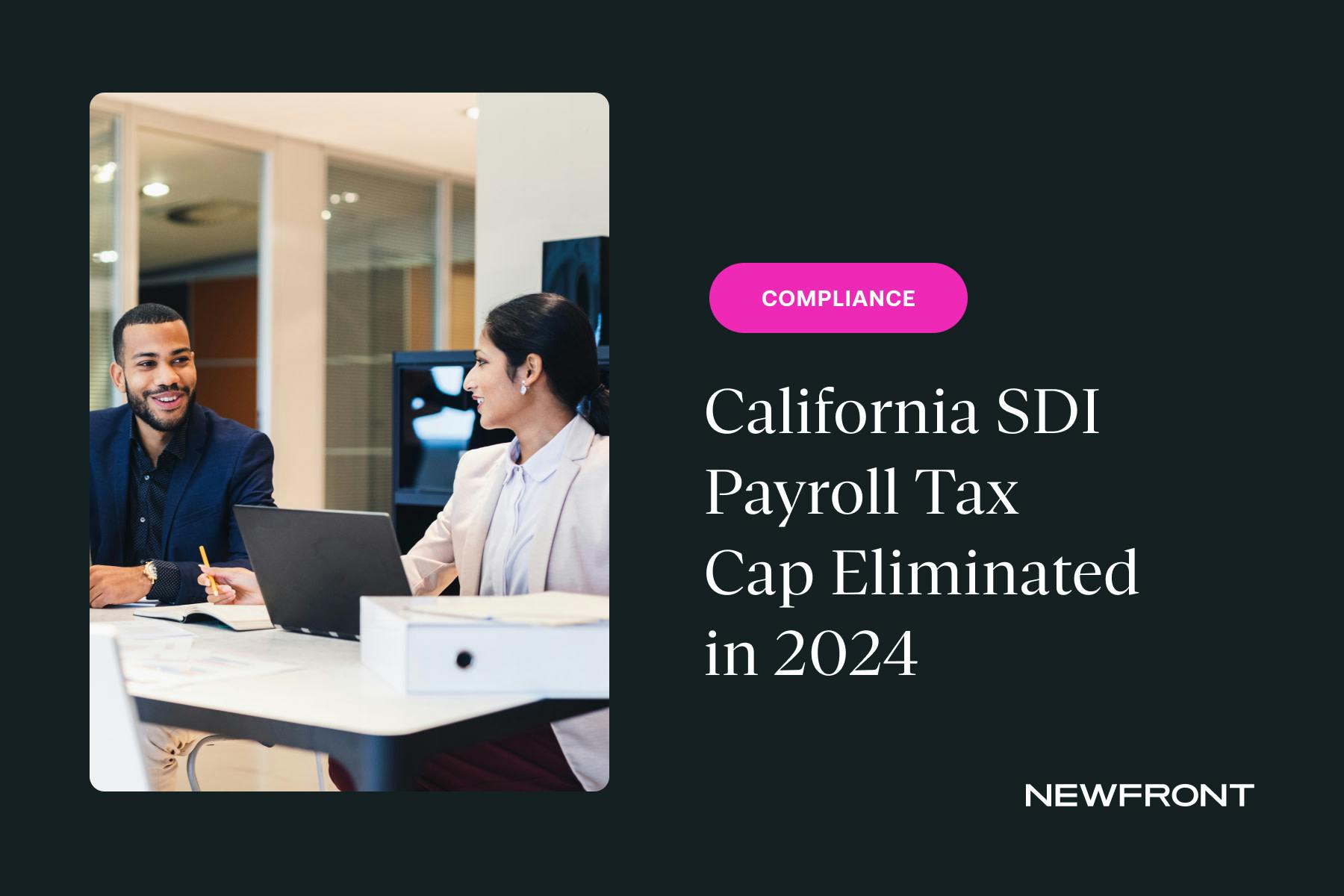California SDI Payroll Tax Cap Eliminated in 2024
By Karen Hooper | Published April 10, 2023

Executive Summary
Governor Newsom signed into law SB 951 in September 2022, resulting in three significant changes to California’s State Disability Insurance (SDI) program, which includes Paid Family Leave (PFL) benefits:
The increased SDI benefit percentage levels that began in 2018 (up to 60%-70% of Average Weekly Wages (AWW)) have been extended through the end of 2024.
The SDI benefit percentage increases again to up to 63%-90% of AWW in 2025; and
These benefit enhancements are funded by the elimination of the taxable wage limit on individual wages subject to the annual SDI withholding rate ($153,164 in 2023) effective January 1, 2024.
History of the Increased SDI Benefit Through 2023
In 2018, California temporarily increased the SDI wage replacement from up to 55% of AWW to up to 60% for individuals who earned one-third or more of the AWW, and up to 70% for individuals who earned less than one-third of the AWW. These enhancements were scheduled to sunset at the end of 2021.
AB 138, enacted in July 2021, extended these changes through 2022. Absent any further legislation, the SDI/PFL benefit would have reverted back to 55% of AWW in 2023. SB 951 saved the day by extending the increased benefit of 60%-70% of AWW through the end of 2024.
Additional Increases to SDI Benefits Starting 2025—Particularly for Lower Wage Earners
Having secured the higher benefit through the end of 2024, SB 951 took this a step further and increased benefits for all claimants effective January 1, 2025.
For SDI and PFL claims beginning on or after January 1, 2025, individuals who earn 70% or less of the state average quarterly wage will receive a benefit of up to 90% of AWW. Individuals who earn more than 70% of the state average quarterly wage will receive a benefit of up to 63% of AWW. Unlike previous benefit increases, these benefit increases do not include a sunset provision.
Elimination of Taxable Wage Limit in 2024
There were earlier attempts to provide California employees with increased SDI and PFL benefits. In 2021, the legislature passed a bill to raise the weekly benefit for PFL and for the first 12 weeks of SDI to between 70%-90% of the employee’s AWW for claims beginning on or after January 1, 2023. However, the legislation did not provide a method to fund the benefit increase, and therefore Governor Newsom vetoed the bill.
SB 951 addresses that funding concern (and thereby secured the Governor’s signature) for the SDI/PFL benefit increases that begin in 2025 by removing the SDI contribution wage ceiling as of 2024. This means that all wages paid will be subject to the SDI tax (currently 0.9%). Needless to say, the removal of the SDI payroll tax cap has the greatest impact on high wage earners.
Examples:
An employee earning $500,000 in 2023 will pay 0.9% of salary up to a maximum wage base of $153,164 for a maximum withholding of $1,378.48. ($153,164 x 0.9%)
Assuming the SDI withholding rate remains at 0.9% in 2024, a California employee earning $500,000 will pay $4,500 ($500,000 x 0.9%) in SDI tax, over 3 times the amount they paid in 2023.
An employee earning $100,000 in 2023 and 2024 would be unaffected by the change and pay the same $900 in SDI tax ($100,000 x 0.9%), assuming the withholding rate remains at 0.9%.
Voluntary Disability Insurance (VDI) Plan Considerations
California Employment Development Department (EDD) allows employers to offer a voluntary disability and paid family leave program (VDI) to its California employees as a legal alternative to the mandatory SDI coverage (which includes paid family leave). The Employer’s Guide to Voluntary Plan Procedures outlines the VDI process and considerations for employers.
VDI plans must meet the following requirements:
Need written approval from the majority of employees eligible for coverage.
Cannot cost employees more than SDI.
Provide all the same benefits as SDI plus at least one that is better.
Employees can reject the VP and choose SDI coverage.
Covered employees must be given a written document that outlines their benefits.
Must be offered to all eligible California employees of the employer.
Must be updated to match any increase in benefits that SDI implements as a result of legislation or approved regulation.
Accordingly, employers cannot avoid the removal of the wage cap (2024) or the impending SDI increases (2025) by moving to a VDI alternative.
One of steps to implement a VDI Plan is the requirement to submit a security deposit with the application. The minimum required security deposit is calculated based on the following formula: Employer’s estimated taxable wages from the previous year x 0.5 x the current SDI contribution rate (currently 0.9%). The increased taxable wages in 2024 resulting from the removal of the cap will therefore increase the size of the required security deposit beginning in 2025.
Furthermore, there is a quarterly VDI administrative assessment paid by the employer to the EDD. The assessment is 14% of the employee contribution rate (0.9% in 2023), coming out to 0.126% of total VDI taxable wages. Although that is a relatively small percentage assessment, the total amount subject to the assessment will increase significantly beginning in 2024 as the removal of the wage cap increases the total VDI taxable wages subject to the 0.126% assessment.
Employers will need to consider all of these factors when reviewing whether a VDI plan may be a suitable alternative moving forward.
Summary
California employees will see increased SDI and PFL benefits in 2025. With the elimination of the payroll tax cap, higher wage earners can expect to see a much larger total deduction out of their paycheck in 2024 to fund the benefit increase.
Lower wage earners in California will benefit the most from the changes in SB 951. Earning a wage below the current cap, they will not see an increase in their SDI contribution, and will receive a greatly increased benefit, providing expanded support for working families.
Disclaimer: The intent of this analysis is to provide the recipient with general information regarding the status of, and/or potential concerns related to, the recipient’s current employee benefits issues. This analysis does not necessarily fully address the recipient’s specific issue, and it should not be construed as, nor is it intended to provide, legal advice. Furthermore, this message does not establish an attorney-client relationship. Questions regarding specific issues should be addressed to the person(s) who provide legal advice to the recipient regarding employee benefits issues (e.g., the recipient’s general counsel or an attorney hired by the recipient who specializes in employee benefits law).

Karen Hooper
VP, Senior Compliance Manager
Karen Hooper, CEBS, CMS, Fellow, is a Vice President and Senior Compliance Manager working closely with the Lead Benefit Counsel in Newfront's Employee Benefits division. She works closely with internal staff and clients regarding compliance issues, providing information, education and training.


